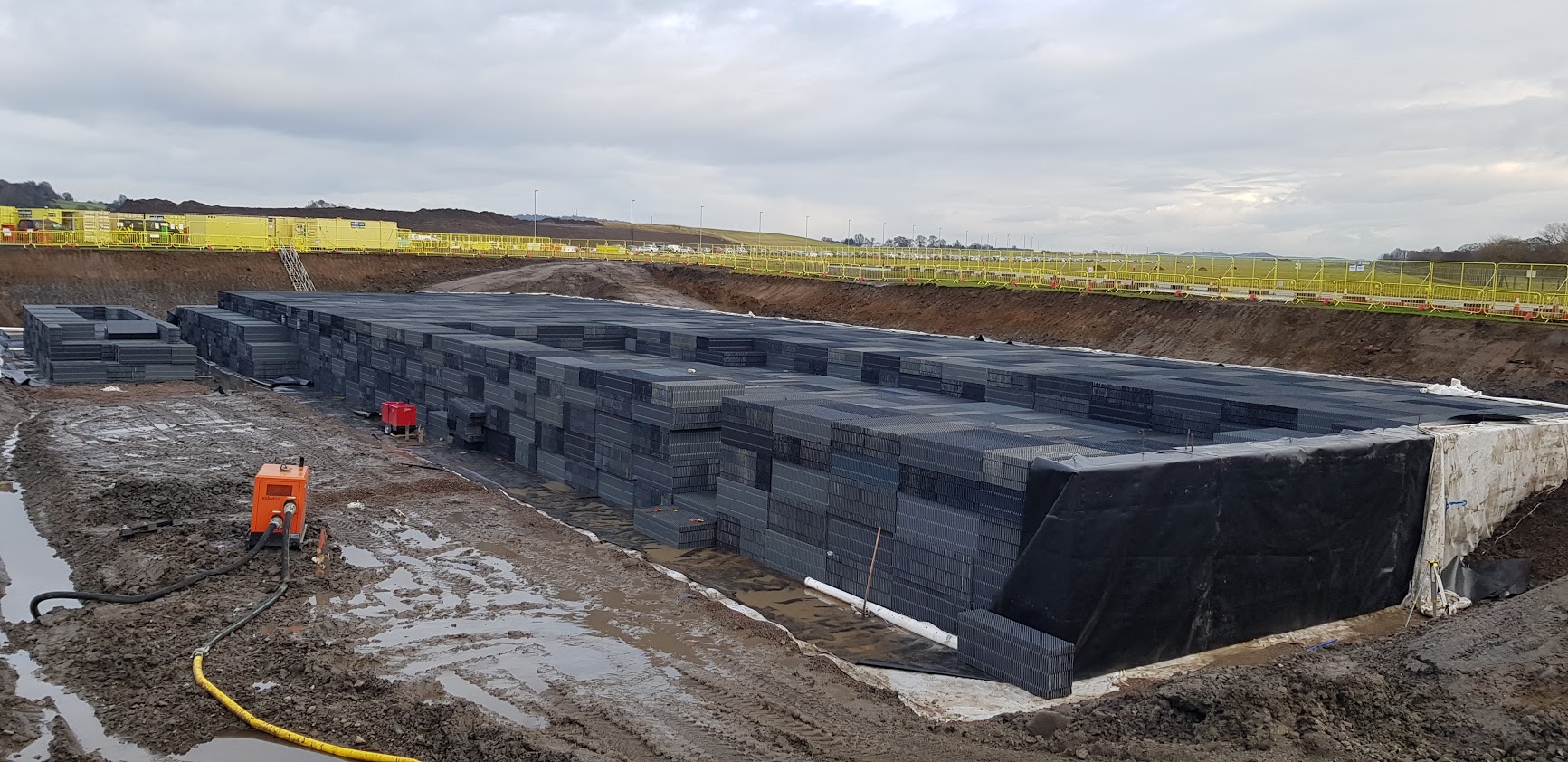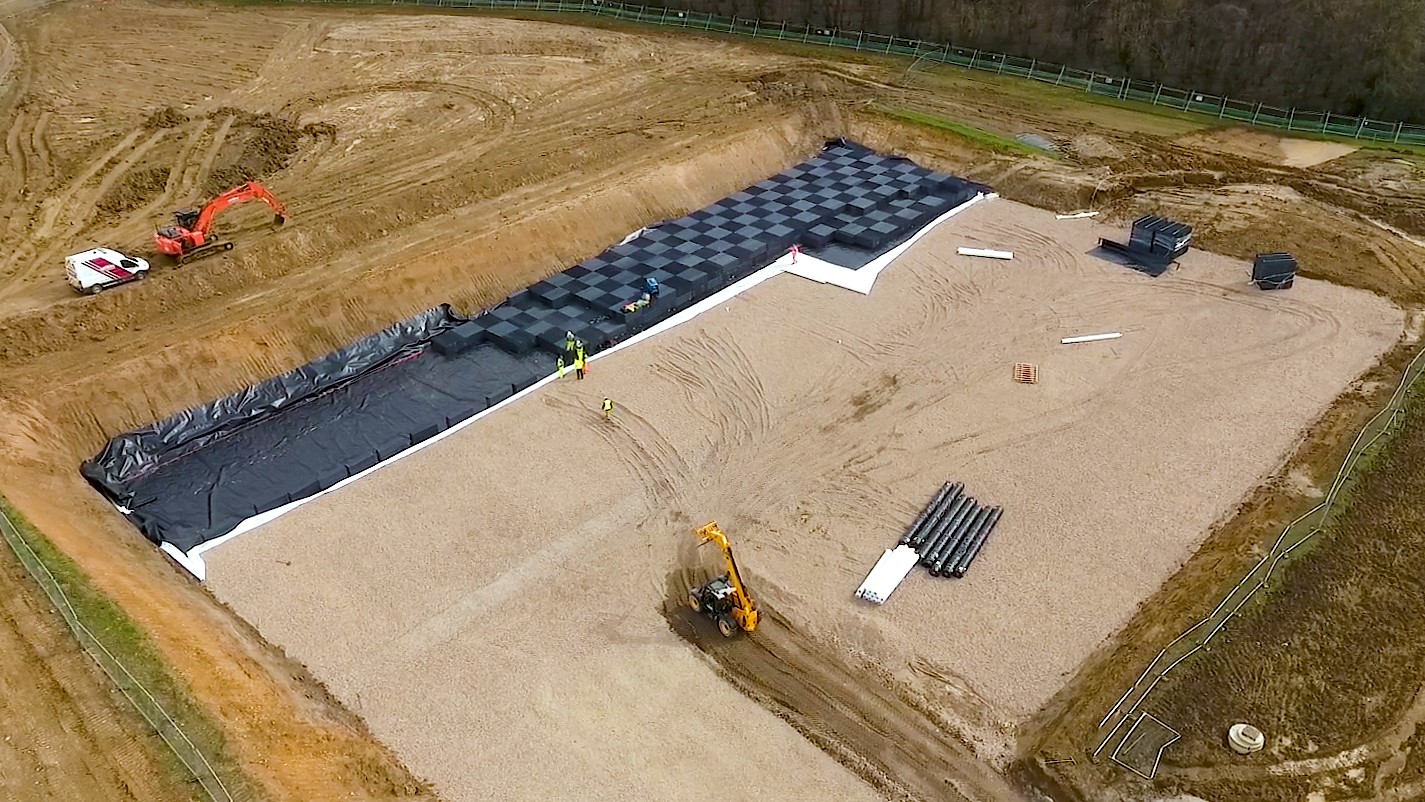Modular geocellular storage is one of the construction industry’s most ubiquitous and, ultimately, invisible building products, an underground workhorse of the drainage world that underpins urban infrastructure everywhere and protects against surface water flooding. Since its invention more than 30 years ago, SDS’s unique modular storage system, GEOlight®, has been the enduring contractors’ and groundworkers’ choice. What makes it a market leader and what’s behind that familiar honeycomb modular structure?
We put the questions to our Business Development Manager, Mark Manning:
Q: Is the need for underground flood storage increasing?
“We know that climate change is going to lead to more extreme weather conditions. Longer periods of drought will be interspersed with more heavy, intense periods of rainfall. Meanwhile, urban creep is resulting in more buildings, roofs, roads and car parks which increase the impermeable area that water runs off in storms. There’s growing pressure for new housing, sometimes making it unavoidable to build in more flood-prone locations.
Not long ago, it was standard practice for underground surface water tank storage to be designed with 30% additional space to allow for climate change. Now, that figure has been increased to 40%. In the past 18 months we’ve seen some of our largest ever GEOlight® projects installed. It could even be the case that the capacity allowance is increased once more.”
Q: Can geocellular storage be used as part of SuDS-compliant schemes?
“As part of SuDS, a flood storage device, whether a pond, wetland or an underground tank, works by capturing and holding back water close to where it falls, allowing it either to infiltrate into the ground or to be discharged at a rate that will not damage the receiving environment.
In tightly-knit urban environments, housing estates or new commercial properties, there may simply not be enough space or opportunity for the drainage to be managed completely above ground. A GEOlight® underground tank can be designed as part of an integrated water management system in conjunction with vegetative features, for example underneath a sports pitch, so there’s amenity as well as additional exceedance flood protection in extreme storms. In such cases, including storage underground enables natural features to be added, providing amenity and biodiversity as part of a SuDS management train.

Q: What makes GEOlight® so different to other systems?
“Since its invention 30 years ago, the unique honeycomb design of GEOlight® has given it big advantages as a building material. A growing requirement for engineers to overcome increasingly difficult site challenges has been met with our provision of an extended range of design options, using different depths and strength options. We manufacture our system in the UK from 100% post-consumer recycled PVC waste that would otherwise have ended up in landfill. Both the material and its structure make it extremely lightweight and inherently strong, compared to other open-voided, or co-polymer crate-type systems, enabling GEOlight® to be installed under all types of road, car park and amenity areas. Together with a very high 95% void rate, this means we can design the maximum volume of water to be stored in the minimum possible footprint.
As a result, GEOlight® helps both contractor and developer to optimise land use, minimise construction time and excavation costs, and reduce muck-away. Because it’s both light and modular, it’s also extremely quick to install – a 1000m3 storage tank can be completed in a week.”
Q: Why is structural strength so important?
“Installing the tank as close to the surface as possible with a minimal requirement for sub-base cover is a key consideration. The unique compressive properties, modular design and choice of strengths, from 200kN/m2 up to 1000kN/m2, make GEOlight® extremely versatile. We will look at the engineer’s design and optimise the tank depth to be as economical as possible for the contractor, even where there is a very shallow fall, or perhaps where we need to achieve varying load-bearing requirements in different sections of a tank system. For example, the contractor might need to take account of the need to use cranes on certain parts of the site, or to designate sacrificial land to stockpile materials – something perhaps not considered when the drainage was originally designed.”

Q: What’s the most important consideration for contractors in implementing stormwater storage?
“Contractors and groundworkers are concerned to de-risk as much as possible. Our customers know that SDS is the only company they can turn to for a ‘one-stop-shop’, UK-based design, manufacture, delivery and installation package. There’s no risky, multi-faceted supply chain and customers can rely on our exceptional capacity to meet site demands.”
Q: How does GEOlight® perform once installed?
“Developers can be reassured of the high load-bearing integrity of our tanks during building, in the time before it is handed over to the adopting authority, as well as ensuring ongoing reliable performance.
The honeycomb structure means GEOlight® is not vulnerable to a catastrophic collapse. Unlike open-voided systems, it can simply compress to absorb the weight even in a scenario where the tank becomes subjected to much greater loads than it was designed to withstand.
When it comes to maintenance, GEOlight® also comes into its own, since the system is effectively self-cleaning. A very simple distribution pipe network prevents any silts from entering the voids of the tank. Only the distribution pipe needs to be maintained, and so less jetting is required. Ongoing inspection and maintenance is therefore kept to an absolute minimum.”
Visit the GEOlight page of our website for more information and resources or contact our team to find out more.
Alternatively take a look at some of our GEOlight Case Studies:
Edinburgh Airport: SDS installs Scotland’s largest stormwater attenuation system
Stortford Fields: SDS provides stormwater attenuation for more than 2,000 homes
Stoke Gifford Rail Depot: Sustainable drainage systems keep train servicing centre flood-risk free



